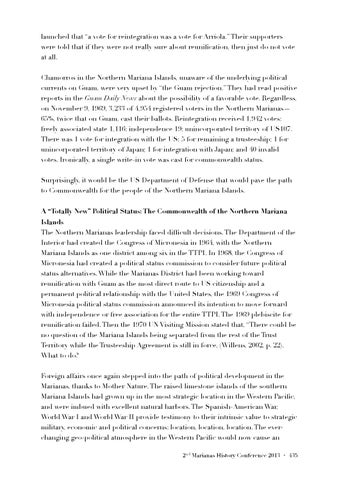launched that “a vote for reintegration was a vote for Arriola.” Their supporters were told that if they were not really sure about reunification, then just do not vote at all.
!
Chamorros in the Northern Mariana Islands, unaware of the underlying political currents on Guam, were very upset by “the Guam rejection.” They had read positive reports in the Guam Daily News about the possibility of a favorable vote. Regardless, on November 9, 1969, 3,233 of 4,954 registered voters in the Northern Marianas— 65%, twice that on Guam, cast their ballots. Reintegration received 1,942 votes: freely associated state 1,116; independence 19; unincorporated territory of US107. There was 1 vote for integration with the US; 5 for remaining a trusteeship; 1 for unincorporated territory of Japan; 1 for integration with Japan; and 40 invalid votes. Ironically, a single write-in vote was cast for commonwealth status.
!
Surprisingly, it would be the US Department of Defense that would pave the path to Commonwealth for the people of the Northern Mariana Islands.
!
A “Totally New” Political Status: The Commonwealth of the Northern Mariana Islands The Northern Marianas leadership faced difficult decisions. The Department of the Interior had created the Congress of Micronesia in 1964, with the Northern Mariana Islands as one district among six in the TTPI. In 1968, the Congress of Micronesia had created a political status commission to consider future political status alternatives. While the Marianas District had been working toward reunification with Guam as the most direct route to US citizenship and a permanent political relationship with the United States, the 1969 Congress of Micronesia political status commission announced its intention to move forward with independence or free association for the entire TTPI. The 1969 plebiscite for reunification failed. Then the 1970 UN Visiting Mission stated that, “There could be no question of the Mariana Islands being separated from the rest of the Trust Territory while the Trusteeship Agreement is still in force, (Willens, 2002, p. 22). What to do?
!
Foreign affairs once again stepped into the path of political development in the Marianas, thanks to Mother Nature. The raised limestone islands of the southern Mariana Islands had grown up in the most strategic location in the Western Pacific, and were imbued with excellent natural harbors. The Spanish-American War, World War I and World War II provide testimony to their intrinsic value to strategic military, economic and political concerns: location, location, location. The everchanging geo-political atmosphere in the Western Pacific would now cause an 2nd Marianas History Conference 2013 ・ !435
